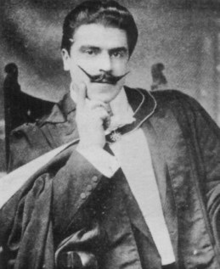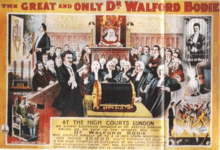Walford Bodie
| Walford Bodie | |
|---|---|
 Photograph of Bodie c. 1900s | |
| Born |
Samuel Murphy Bodie 11 June 1869 Aberdeen, Scotland |
| Died |
1939 (aged 69–70) Blackpool, England |
| Burial place | Macduff, Scotland |
Walford Bodie, whose real name was Samuel Murphy Bodie (1869–1939), was a Scottish showman, hypnotist, ventriloquist and stage magician, famous for his 'mock' electrocutions involving a replica of 'The Electric Chair'. He also performed an act of 'Bloodless Surgery', claiming he could use electricity, hypnosis and manipulation to cure 'all kinds of ailments and disabilities.'[1] His performances were enormously popular in the early 20th century, and inspired both Harry Houdini and Charlie Chaplin.[2]
Charlie Chaplin imitated Bodie on stage in 1906, and continued to do so in Hollywood years later, while Bodie and Houdini were firm friends for many years. Numerous letters were exchanged between the two. Walford Bodie claimed to be the 'Most Remarkable Man on Earth,' and at one stage, in the Edwardian decade, the handsome young Scotsman became one of the world's highest paid entertainers; if not the highest. His 'Show Cures,' performed as part of his 'Bloodless Surgery,' be they good, bad or indifferent, had brought him spectacular success. Bodie advertised freely; his show posters even including the invitation 'Send Your Cripples.'[3]
In 1905, his 'cures' had made him so famous that he was made a 'Freeman of the City of London,' the first of his kind to receive such an honour. From this, he made his fortune, set up his 'Bodie Electric Drug Co,' and published his 'Bodie Book.' None of which pleased the medical profession, who'd labelled him a 'quack,' and had already taken him to court over the use of the word 'doctor.'
Yet Walford Bodie was also a great showman, and stage performer, and it was the combination of great showmanship, as well as his apparent 'cures,' that provided the magnet for his huge success. Ricky Jay, the iconic American hypnotist, and author of the best-selling book, 'Learned Pigs and Fireproof Women,' accredits Bodie with the origination of many of today's comic interludes in stage hypnotism. In other words, the originator of much of the 'humorous hypnosis' we see on stage to this very day, while Professor Edwin A. Dawes states that 'as a ventriloquist (in his later stage review, 'Fun on an Ocean Liner') he was superb.'
Biography
Birth & Early life
Bodie was born in Aberdeen, Scotland, on 11 June 1869. At the age of 14, he became an apprentice at The National Telephone Company, something that would impact on his later career choice. Two years afterwards, he began performing live at places like Stonehaven Town Hall in Kincardineshire. During this time, he would build his reputation, performing acts that involved illusions, ventriloquism, hypnotism and other magic tricks.[1]
'The Electrical Wizard'
Before long, the young Bodie began experimenting with electricity in his shows, and touring the British Music Hall circuit, building up his reputation as the 'Electrical Wizard' and the 'British Edison'; his performances often using an electric chair to shock members of the audience with static electrical charges which, despite the appearance that horrified audiences, posed no type of lethal threat.
At the climax of the act, Bodie would strap himself in, assisted by 'La Belle Electra', his assistant, and seemingly pass 30,000 volts through his body, lighting up sixteen light bulbs and even two lamps he held in his hands.[4] In 1920, his friend Harry Houdini would gift him the real Electric chair, used in the first execution at Sing Sing Prison.[4]
Trials

Despite his success, Bodie's popularity was not met entirely with open arms. His 'cures' and the self-imposed title of 'Doctor' (or M.D.) angered members of the medical profession, and in 1905 he was taken to court for the use of the suffix 'M.D' by the Medical Defence Union. Bodie claimed that he had inadvertently left off the suffix 'USA' and was given a slap over the wrist. What he didn't tell the court, though, was that he'd purchased his 'USA doctorate' from a dentist in Bradford. In 1909, he was sued by a former 'principal assistant,' Charles Irving, for alleged misrepresentation. Ever the showman, Bodie claimed that the initials 'M.D.' did not stand for a medical title, but rather the nickname 'Merry Devil', a term which would stick to him for the rest of his days.
He lost the legal battle,[4] and was forced to pay £1000 in compensation.[1] His colourful 'Great Bodie Trial' poster (see right), produced after the trial, was strikingly similar to Harry Houdini's 1902 'German Court' poster. Walford Bodie was an enigma, and his life a never-ending drama. In 1916, his ship was torpedoed and sunk on the way back from the Middle East, where he'd also followed in the footsteps of Harry Houdini. Read more about Bodie's flagrant use of the term 'M.D,' his womanising, and his Middle Eastern tour.
A week after the 'Great Bodie Trial,' at the instigation of the medical profession, and under the leadership of an Austrian Jewish student by the name of Philip Figdor, his reputation was forever tarnished when 1000 students rioted at his performance in the Glasgow Coliseum. Bodie was pelted with eggs and rotten food by the students, who chanted 'Bodie, Bodie, Quack, Quack, Quack' as he stood his ground, before hurriedly departing the stage as police attempted to hold back the now uncontrollable mob.[4] Three days later, a mob of angry students attacked Bodie's London premises, after burning his effigy in the street, and assaulting police to gain entry. The riots have been described as the worst student riots in Scottish history.
Bodie was devastated by the riots, and almost destroyed. He was forced to take a year off to recover, write books, and reinvent his act. He made a recovery of sorts in 1912, when he outdrew the great Harry Lauder in Aberdeen, and held his own until the 1920s, when his now variety-based 'Bodie Show' began to take root again. In the early 1930s, Bodie owned a London nightclub, and a houseboat (his 'floating palace'), which he named 'La Belle Electra.' He and his second wife were said to entertain lavishly, and the guest list was said to include the future king, Edward VIII, and his fiancee, Wallis Simpson. The mid 1930s depression, though, told a different story, when Bodie was forced to perform at smaller venues. He collapsed on stage in 1939, and died, days later, at the age of 70, after the end of a season at the Blackpool Pleasure Beach. His body was returned to and buried in Macduff.[1]
Personal life
Bodie was not without compatriots. In the 1906 'Leeds Court Case,' Justice Grantham summed up in his favour, as follows (in part):- 'Perhaps his methods might not suit the taste of all – and it was well known that doctors were jealous people – but we have evidence of cases where doctors have failed, and which have been cured by Doctor Bodie's treatment. There was no doubt that he (Doctor Bodie) had done a great deal of good. He could not be stigmatised as a 'quack' or an impostor.'
In the Florence Tudor articles, from the 1970s, published in 'The Scotsman,' the preface reads:- 'Some believe that he was a charlatan, but Florence Tudor defends his reputation, and claims that, as well as a superb showman, he was a pioneer of medical techniques.' Florence Tudor goes on to describe Bodie as a 'misunderstood genius.'
Bodie was married twice. His first marriage was to Jeannie Henry, the eldest of eight talented sisters. and the second eldest in a family of eleven. Seven of the siblings would become part of the 'Bodie Show,' at one time or another, including 'La Belle Electra,' and 'Mystic Marie,' who played the part of Trilby in the 'Svengali Segment.' Jeannie's elder brother, Edward, a talented pianist, would play at the Albert Hall, before finishing life as a busker in Canada. Bodie and Jeannie produced three children, Albert, who was born in 1889 and died in 1915, Jeannie, who was born in 1890, and died in 1909, and Samuel, who was born in 1896, became a 'properly qualified' medical practitioner, and died in 1974.
In 1931, Jeannie died, and not long after, Bodie married an attractive 22-year-old showgirl by the name of Florrie Robertshaw.[4] It was well known in show business circles that the handsome Walford Bodie had been an ardent womaniser, and his second marriage, to a much younger woman, was typical of the man. A man who'd once advertised himself as 'a sedulous artiste, whose acquisitions are legion.' Yet all this only added to the general public's never-ending fascination with both the great showman – and the enigma. The man known as Walford Bodie, 'Merry Devil.'
In 2005, a book was published, detailing Bodie's exploits called Showmen or Charlatans?: The Stories of 'Dr' Walford Bodie and 'Sir' Alexander Cannon by Roger Woods and Brian Lead.
References
External links
- Daily Record-the shocking story of master showman Walford – An entire news report on the life of Dr Bodie.
- Dr Walford Bodie at www.voltini.com